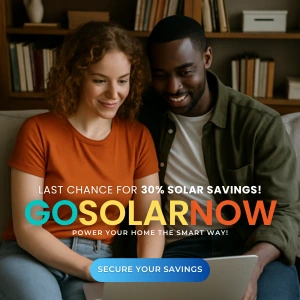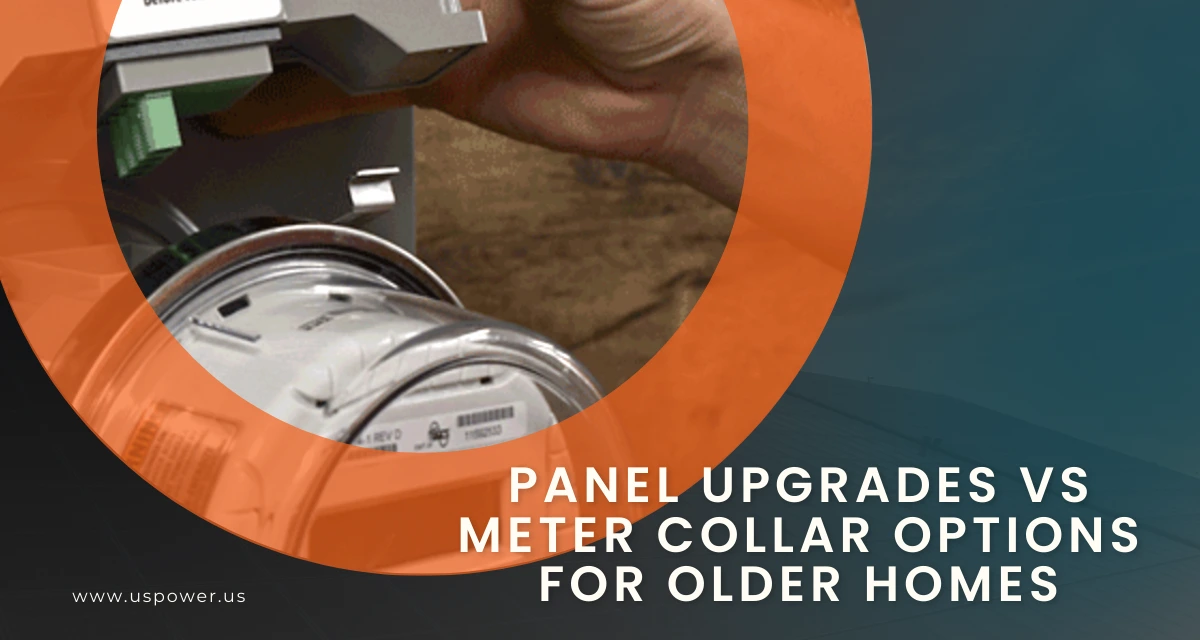Why a Bollard Might Be Required for Your Solar or EV Equipment

Solar and Roofing Advisor
Avoid inspection delays! Find out when SoCal inspectors require CEC 110.27(B) bollards for solar and EV setups near driveways. Switch to solar with US Power.

Homeowners often assume that if the battery storage (ESS) is mounted safely elsewhere, no extra protection is needed for driveway-adjacent equipment. As a solar consultant at US Power, serving Southern California homeowners, I’ve seen how this assumption leads to inspection failures and project delays.
By understanding when and why a bollard is required, you can avoid costly re-work, keep your permit timeline on track, and protect your investment with confidence.
What Homeowners Are Seeing
In many residential solar + EV charger installations across Los Angeles, Ventura, and Orange Counties, inspectors have begun requiring bollards (steel posts) to protect equipment mounted near driveways or parking areas.
Even if your energy storage system (ESS) is installed elsewhere, inspectors may flag combiner boxes, system shutoffs, or EV chargers that appear exposed to vehicle movement.
It’s a common situation that catches homeowners off guard—and it’s happening more often as inspection standards tighten across California.
Why the Requirement Exists (and the Code Basis)
Key Code Reference
The requirement stems from California Electrical Code (CEC) 110.27(B), which states:
“In locations where electrical equipment is exposed to physical damage, it shall be protected by approved enclosures or by suitable guards.”
In simple terms: if a car could hit it, it needs protection.
Application: Driveway Wall Equipment
Even if no battery is nearby, driveway-mounted equipment such as inverters, disconnects, or chargers is considered “subject to physical damage.” Inspectors view proximity to vehicles as enough justification to require physical barriers.
Local Enforcement
Different cities apply this rule differently, but LA County, Ventura County, and Orange County inspectors are consistent: equipment near driveways must be protected by a curb, wall, or bollard. Their logic? It’s easier to prevent damage than to repair a system failure after the fact.
When a Bollard Is Typically Required
From our installation experience at US Power, here’s when inspectors usually demand a bollard:
- The electrical equipment is mounted on a wall beside a driveway or parking area.
- There’s no curb, planter, or fence separating the equipment from the vehicle path.
- The components are installed less than 48 inches above ground (within bumper height).
- The driveway is narrow, or the vehicle passes close to the wall.
- The inspection report lists “exposed to physical damage” as a comment.
If one or more apply, expect to install a bollard or equivalent protection.
When You Might Be Able to Avoid a Bollard
You may not need a bollard if:
- The equipment is mounted high (over 48–60") and clearly above vehicle reach.
- There’s a structural barrier, like a retaining wall or planter.
- The equipment is set back at least 6–8 feet from the vehicle path.
- You can document existing protection in the permit drawings or photos.
Always confirm this early—each Authority Having Jurisdiction (AHJ) can interpret “subject to damage” differently.
US Power’s Professional Recommendation
At US Power, we’ve managed thousands of solar installations and inspections across Southern California. We’ve seen homeowners lose weeks to minor code issues like this, which could have been avoided with proactive design.
Here’s how we approach it:
Step 1: Site Survey & Vehicle Path Review
We analyze your driveway layout to see if any mounted equipment is within a car’s turning radius or entry path.
Step 2: Optimized Equipment Placement
Whenever possible, we mount the combiner, system shutoff, and EV charger in the side or rear areas, or elevated beyond bumper height.
Step 3: Plan for Protection When Needed
If the driveway is the only viable location, we specify removable bollards, low-profile barriers, or curbed planters that meet code and maintain curb appeal.
Step 4: Document Everything
We include bollard or guard details in the permit package, labeled per CEC 110.27(B). Inspectors see this upfront, avoiding re-inspection delays.
Step 5: Post-Inspection Verification
After system activation, we verify that protection remains in place and that the homeowner is satisfied with both appearance and compliance.
Expert Opinion: Smart Protection, Not Overkill
Some homeowners consider bollards unnecessary—especially if they’ve never had an accident in their driveway. But from a safety and warranty standpoint, they’re worth every dollar.
A single vehicle bump could:
- Damage inverters or electrical conduits
- Trigger warranty voids or system downtime
- Create potential fire or shock hazards
At roughly $150–$300 installed, a bollard is inexpensive insurance that ensures compliance and peace of mind.
In short: It’s not about battery protection—it’s about vehicle exposure.
Case Example
A homeowner in Sherman Oaks recently installed a Qcells solar system with an EV charger mounted on the side wall of a narrow driveway.
The battery storage was located in the backyard, far from vehicles. Yet, the city inspector cited CEC 110.27(B) and required a bollard for the wall-mounted charger.
The delay cost the homeowner two weeks and an extra $250 for re-inspection.
If the bollard had been included in the design phase—as US Power typically does—it would have passed on the first inspection.
What to Ask Your Installer Before Signing
Before your project begins, ask your installer:
- Is my equipment near a driveway or parking area?
- If so, what type of physical protection are we including?
- Will this be documented in the permit drawings?
- Who covers additional costs if an inspector requests a bollard after installation?
At US Power, our answer is simple: we plan for compliance from day one. No surprises. No delays.
Final Takeaways for SoCal Homeowners
- CEC 110.27(B) gives inspectors authority to require bollards for any electrical equipment at risk of vehicle impact.
- This applies even if your ESS is located elsewhere.
- Adding a bollard early prevents re-inspection costs and project delays.
- US Power designs systems that meet local AHJ interpretations from the start.
- A properly protected system improves safety, resale value, and long-term reliability.
How US Power Helps You Pass Inspection the First Time
As Southern California’s trusted solar consultant and installer, US Power provides a complete, end-to-end solar experience tailored for homeowners. Every project begins with an expert site survey and precise equipment placement planning to ensure optimal performance and compliance. The company offers factory-direct Qcells solar panels—American-made and high-efficiency—along with battery storage and EV charger integration for a seamless clean energy solution. US Power also manages all permitting and inspection coordination from start to finish, backed by transparent guidance on every code requirement so your system passes inspection the first time and delivers lasting energy savings.
We ensure every installation is safe, compliant, and inspection-ready—so you can start saving faster and enjoy the benefits of clean, reliable solar power.
Ready to install solar or EV charging at home?
Book your free consultation today.
We’ll design your system for maximum energy savings, minimal inspection delays, and total peace of mind.
Frequently Asked Questions
Artículos relacionados
Nuestros blogs relacionados
Panel Upgrades vs Meter Collar Options for Older Homes
Electrify older SoCal homes smartly with US Power—skip huge upfront panel upgrades.
Complete Guide to Solar Panel Size
Get clarity on solar panel sizes, wattage, and roof space requirements for your home.
Solar in Winter? Keep Saving This Winter with Solar Power
Save even in winter—Qcells and US Power make solar efficiency a year-round benefit.








Empoderamos a las comunidades y las empresas para que aprovechen las energías limpias y renovables energía solar soluciones que impulsan el crecimiento sostenible.
Derechos de autor © 2025 US POWER | Energía solar y techosUS Power - Axia by QCells. All Rights Reserved.
La privacidad es importante para nosotros, por lo que tiene la opción de deshabilitar ciertos tipos de almacenamiento que pueden no ser necesarios para el funcionamiento básico del sitio web. El bloqueo de categorías puede afectar a su experiencia en el sitio web.
Imprescindible
Estos elementos son necesarios para habilitar la funcionalidad básica del sitio web.
Personalización
Estos elementos permiten que el sitio web recuerde las elecciones que ha realizado (como el nombre de usuario, el idioma o la región en la que se encuentra) y proporcionan funciones mejoradas y más personales.
Mercadeo
Estos artículos se utilizan para ofrecer publicidad que sea más relevante para usted y sus intereses.
Analítica
Estos elementos ayudan al operador del sitio web a comprender cómo funciona su sitio web, cómo interactúan los visitantes con el sitio y si puede haber problemas técnicos.
Nosotros y nuestros socios externos utilizamos cookies y otras tecnologías para mejorar y rastrear su experiencia en este sitio, realizar análisis y personalizar el marketing para usted. Al usar el sitio, aceptas que usemos estas tecnologías, incluido el registro y el monitoreo de tus interacciones con el sitio.
¡Obtenga una estimación solar instantánea usando el satélite!










